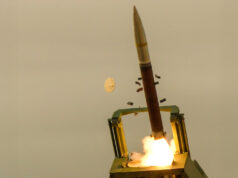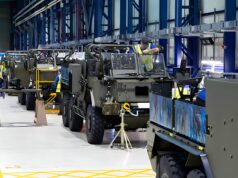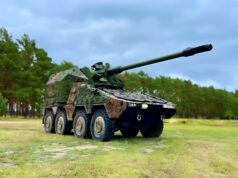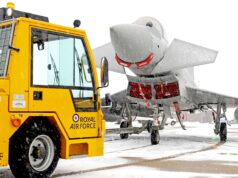Raytheon Rheinmetall Land Systems, a joint venture formed by Raytheon Company and Rheinmetall Defence, has submitted its bid for the U.S. Army’s new Optionally Manned Fighting Vehicle, or OMFV, programme. The team will offer the next-generation Lynx Infantry Fighting Vehicle.
The firms say that Lynx is a next-generation, tracked armored fighting vehicle “designed to address the critical challenges of the future battlefield”.
“U.S. Army soldiers deserve the best possible fighting vehicle when they go into battle and that’s exactly what this team is offering,” said Sam Deneke, Raytheon Land Warfare Systems vice president.
“Lynx provides unparalleled troop protection and features advanced technology that will keep our men and women in uniform ahead of the threat.”
Scheduled for fielding in 2026, the OMFV is expected to replace the Bradley fighting vehicle.
“Our team has spent the last year assembling a U.S. supply chain to ensure that Lynx will be built in America by American workers,” said Ben Hudson, global head of Rheinmetall’s Vehicle Systems division.
“This next-generation combat vehicle will help save lives on the battlefield and further bolster the U.S. industrial base – now that’s a win-win.”
Raytheon technology earmarked for the Lynx includes the company’s, Active Protection System, third-generation thermal sights, Coyote unmanned aircraft system and cyber protection.













I thought they where disqualified as the vehicle needed to be at the testing ground in the States and it is still sat in Germany.
Gunbuster wrote:
“”I thought they where disqualified as the vehicle needed to be at the testing ground in the States and it is still sat in Germany.””
Yup from defence news two days ago:
Lynx 41 disqualified from Bradley replacement competition
WASHINGTON — The Army has disqualified Raytheon and Rheinmetall’s bid for the Optionally Manned Fighting Vehicle prototype competition, Defense News has learned.
The OMFV is meant to replace the service’s Bradley Infantry Fighting Vehicle. The Army’s plan was to take the bid samples submitted this week, evaluate them over a period of time and then choose two companies to deliver 14 prototypes each and then would pick a single winner after further evaluation. The Army’s goal was to begin replacing Bradleys in 2026.
The Army would not comment on the disqualification and said in a statement sent to Defense News that the solicitation for the OMFV prototyping effort closed on Oct. 1 and “we are now in the competition sensitive Source Selection Evaluation process.”
The service noted in the statement that it “remains committed to rapidly execute the Optionally Manned Fighting Vehicle program,” its number two modernization priority. But multiple sources have confirmed that the bid — Rheinmetall’s Lynx 41 Infantry Fighting Vehicle — was disqualified and the bid sample, the only one in existence, remains in Germany at the company’s facility in Unterluss.
Someone must have screwed up big time if they failed to me the date. Is it between the CV90 then and that General Dynamics offering based on Ascod.
If the vehicles are fully digitised I’m guessing the unmanned part is just a matter of writing the software code, so in theory Ajax could be converted to unmanned if the required software was written and installed.
No BAE withdrew the CV90 development some 6 months ago – leaving only GD according to Defence News.
The world of defense procurement baffles me. If there is only one bid running then it will need to be re-run. So Lynx are saying the issue was down to getting permission to ship it across and offered to let the US lock it up on Germany to prove it wasn’t still being worked on. The requirements and time scales do seem very unrealistic. I don’t understand why everyone would pull out before being rejected unless they know its best way to get the US to update the requirement or time lines if they know they are unrealistic.
I think they can still enter their vehicle but at a later date.
I think it’s a theme with everything nowadays as we seem to have an optionaly manned democracy and Parliament! Sorry, will try to avoid politics today……Back to the story, but replace the Bradley by 2026? Maybe a little ambitious with the timeframe. How is the Bradley holding up, you don’t seem to hear much about it nowadays, is it in shit state like the Warrior? I know the US stopped deploying Bradley on operations about 10 years ago and stuck with MRAPs. Haven’t seen any Saudi M2s deployed in Yeman?
A topic to avoid maybe, but not an inaccurate statement!
Don’t know much about the state of the Bradley, but the only Saudi vehicles I’ve seen are those that the Yemenis blew up the other week- all LAVs and MRAPs…
The Bradley’s are actually in pretty good shape plenty were produced to keep the spare parts production going and they continue to be upgraded. The reasons it isn’t being deployed as much is the lack of a V-hull and the prevalence of IEDs.
Reading the blurb, they say they’ll weigh in between 37 and 55 tons…. They’re not small then !
What you can’t just casually drop “optionally manned” and not elaborate on it, where are my robo-tanks?
Also rumoured to be in the works, is a new MBT to replace the M1? A possible 2030 date could offer the UK an opportunity to become a fellow player in the project? The plan is to begin mid next decade the development of an optional unmanned or manned vehicle, and could be an ideal replacement for the CH2? We simply don’t have enough CH2’s and this M1 programme would offer an opportunity to field a much-improved fleet, both in numbers and capability?
I believe France and Germany have already signed a collaborative project and Poland is looking to join. I can’t see the UK getting much work share from an American program but might be better joining the European one and staying the course. Poland will be the key European customer, France and Germany will likely do the usual order of 1,000 tanks to get work share and then cut it to 100 each when it comes to actual orders.
What you say is interesting, but there may be a bigger international market for MX2 whatever they call it. The political landscape may change in the future where UK co-operation is not sorted by the EU key players? The UK will be perceived as an even closer American ally in the next thirty years, thus making more strategic sense to align with the US vehicle project? If we take Desert Storm and the Iraq Invasion, those operations were dominated by US/UK forces and interoperability, would have been key, if both wars had been a protracted hard fight?